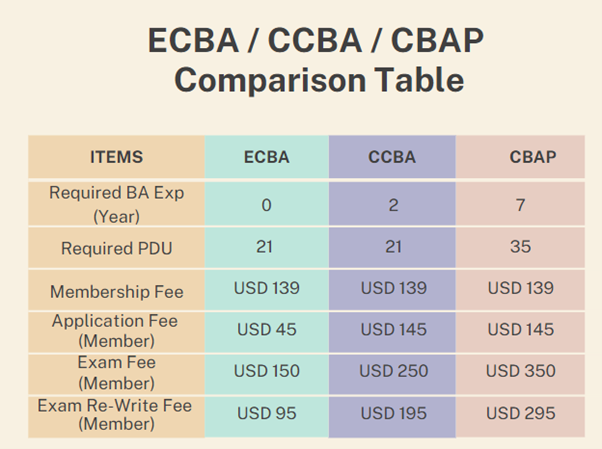You Made The Decision To Pursue CBAP Certification, Now What?
I have been a Business Analyst for more than a decade and have recently decided to go for it! It being the IIBA CBAP (Certified Business Analysis Professional) certification. As any BA would do, the moment I decided to go for it, I immediately went into information gathering mode! I l researched and gathered as much information as I could find. I signed up for several IIBA webinars and LinkedIn learning modules pertaining to the CBAP certification. Here are the top ten tips I took away from my research:
- Use the business analysis skills you currently possess to develop your CBAP certification roadmap or project plan!
- Layout the tasks and actions you must complete. Such as: complete and submit your application, read the BABOK and/or Core Standards, collect your references, decide if you prefer self-study or a paid training program, plan for the 35 hours of professional development, etc.
- Define a timeline with target dates. I feel like this is a personal preference item. You want to set yourself up for success while ensuring you do not extend the timeline out too far. For myself, I set a 6-month timeline. I expect to take the exam at no more than 6 months from the time I officially started the process. I felt that a longer duration of time would either welcome procrastination or give too much time for me to tart second guessing my readiness.
- Organize and prioritize the required tasks and actions. For example, ensure the most time intensive activities fit into the timeline you have defined for yourself. What activities are expected to take the longest? The study of the BABOK? The 35 hours of professional development?
- I have heard and read, multiple times, ‘do not wait to start capturing your work experience.’ It takes time to record 7500 hours of business analysis experience. It is a tedious task that doesn’t feel so bad if it is done is smaller increments at a time.
2. There are so many resources available. Many of which can be applied to the required professional development hours (WIN-WIN).
-
- If you are a member of IIBA, there are many IIBA chapters that offer IIBA certification study groups. Tip: These count toward professional development hours
- There are several free webinars, recorded and live, that offer insight into how best to prep for the certification. Tip: Many of these webinars count toward professional development hours
- There are a vast variety of articles that cover key things to know before going into the exam. Little golden nuggets of useful insights and tips for success!
- Again, if you are an IIBA member, there are several IIBA endorsed providers that offer professional training programs to guide you through the learning process and prepare you for certification.
3. Much to my delight, every resource I tapped into provided consistent information.
-
- I don’t know about you but when I find consistent info from search to search and source to source, I feel better about the validity of the information! I am more inclined to trust it as truth and feel confident that I can rely on it to support my decision-making process.
4. Do not assume your years of experience as a Business Analyst negates the need to study the BABOK in preparation for the exam!!!!
-
- I rank this my number 1 learning as I searched for information! We Business Analysts tend not to make assumptions when engaging in the activity of business analysis, however, this message was pressed in every study session, webinar and article I read which to me meant it is a common mistake made by seasoned professionals. A mistake I could have easily made if I had not sought out information and looked for guidance on how best to approach the CBAP certification process.
- As BA’s we exercise our business analysis skills and apply business analysis tools daily, however, we do not use the BABOK vernacular or think about how the work we do fits into the six knowledge areas defined in the BABOK. Hence the importance of reading the BABOK to gain a thorough understanding of the six knowledge areas.
- Reading a nearly 500-page book cover to cover is a bit much. Some will advise that you read the BABOK multiple times to prep for the certification. Sone will advise you scan the BABOK and focus on the Core Standards (a condensed version of the BABOK). I say this is another area that is completely personal, based on the individuals learning style. I struggled with determine my approach to this activity for a bit!
Advertisement
5. Spend a good portion of your study time and effort ensuring you have a thorough understanding of the requirements analysis and design definition knowledge area.
-
- This knowledge area makes up about 30% of the CBAP exam. I cannot confirm this statistic myself, however, I can say this statistic has been referenced/shared in a number of the sources I have tapped into. Given this, I have assigned more weight to this key knowledge area to ensure I understand the elements involved in the requirements analysis and design definition knowledge area.
6. Know the 50 BABOK techniques.
-
- Yes! There are 50. The best piece of advice I have heard on this item is to think about the techniques in practical terms within the context of the six knowledge areas. This is not to say a technique cannot be applicable to multiple knowledge areas, this is simply a way to connect the technique to activities that you an associate to the six knowledge areas for purpose of understanding the techniques in a practical manner. For Example:
- It is common to use techniques such as brainstorming, focus groups, and workshops in elicitation and collaboration
- It is common in requirements analysis and design definition to use concept modeling, decision modeling, user stories and use cases.
- Solution Evaluation may involve root-cause analysis and vendor assessments
- Yes! There are 50. The best piece of advice I have heard on this item is to think about the techniques in practical terms within the context of the six knowledge areas. This is not to say a technique cannot be applicable to multiple knowledge areas, this is simply a way to connect the technique to activities that you an associate to the six knowledge areas for purpose of understanding the techniques in a practical manner. For Example:
- Memorize the Financial Calculations and Formula in the BABOK
- The last time I had to memorize formula was probably an accounting class or statistics class in college! I happen to use calculations in my current business analysis role but none that are in the BABOK. Memorizing formula was not something I expected to encounter as I prep for CBAP certification.
- An example of a formula you may need to know is the formula to calculate ROI (return on investment). Total Benefits -Cost of the Investment/Cost of the Investment.
- Another formula example would be the calculation of Net Present Value. Present Value- Cost of Investment.
- In addition to memorizing the calculations and formula, you must be able to interpret the results of the calculations and utilize those results to answer textual questions.
- Utilize mock exams and practice tests!!
- Going back to the decision to read the BABOK cover to cover or not. I chose to take a few mock exams to see how I fared. I did this to assess how exam ready I was before determining if reading the BABOK cover to cover was necessary.
- Mock tests are GREAT! Here’s why:
- They are timed, same as the CBAP exam. Hence, you experience the same stress you will experience when taking the actual exam. You will get a feel for how long you may need for the simple multiple-choice questions and/or the case based and scenario-based questions.
- You gain insight on how complex the scenario or case-based questions are. You learn how best to break them down for purpose of selecting the best answer
- You see how memorizing key concepts, vocabulary, terms, and techniques is not enough. You must be able to apply the concepts, the techniques, and the knowledge to scenarios from a real-world perspective. Essentially demonstrate an in depth understanding of not only the material covered in the BABOK but how to apply that knowledge to your business analysis activities.
- Optimal approach to the Case-Based and Scenario-Based Questions
- Case-based questions are intense! They are multi paragraph scenarios. Followed by multiple questions about the case scenario.
- The very first mock exam I took, I scored at about 50%. Eye opening results If I had not already read that an individual going into the exam blind, assuming they have the knowledge to ace the exam based on their years of business analysis work are likely to score in the 50% range. (I confirmed that statistic!).
- This golden nugget of information was a game changer for me!!! I attended a webinar; in this webinar the host advised, the best approach to the case-based questions is to read the question and answers first, followed by the last paragraph of the scenario.
- I took my next practice exam. I jumped closer to a 70% accuracy rate. Why do I believe this approach improved my results? I started with the end in mind. I knew what I was looking for because I had the question and potential answers in mind before I started looking for the information that would lead me to the correct answer. And I saved time by not reading and rereading the scenario. Again, GAME CHANGER!!!!
- Case-based questions are intense! They are multi paragraph scenarios. Followed by multiple questions about the case scenario.
10. Last but certainly not least. There is no time like the present!!
- If you are thinking about pursuing CBAP certification jump in and go for it!
- never know if you never try!
- Skilling Up is more important than ever!
I am currently on my journey to CBAP certification. It is equally exciting and nerve-racking! I hope you find this information as useful as I have!










